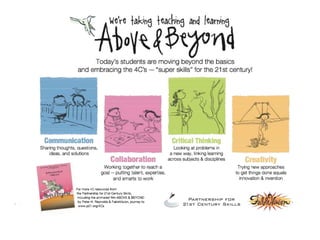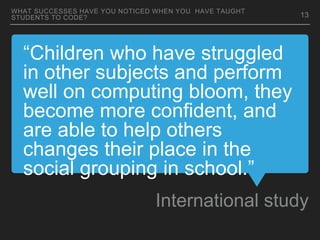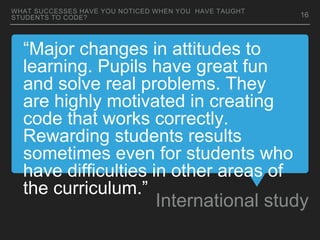Why Should we Teach Kids to Code?
- 1. 1
- 2. WHY SHOULD KIDS LEARN TO 2
- 3. REASONS KIDS SHOULD LEARN TO CODE 3 Economic
- 4. 4
- 5. And itŌĆÖs not just tech companies fighting for talent. The publisher Houghton Mifflin Harcourt Co., for example, is expanding its digital offerings and recently moved its Incubation Lab, which develops technology products for education, to Boston from East Hartford. Claudia Reuter, the senior vice president who leads the lab, said hiring software developers for her 15-person team has been a challenge. ŌĆ£We are the publisher of ŌĆśThe Lord of the Rings,ŌĆÖ ŌĆØ she said. ŌĆ£People donŌĆÖt think of us as a tech company.ŌĆØ Boston Globe ( 2/19/2016) ŌĆ£NOT JUST TECH COMPANIESŌĆØ 5
- 6. 6
- 7. 7
- 8. 8
- 9. COMPUTATIONAL THINKING STANDARDS IN THE UK Ō¢ĖBy the end of 8th grade, all pupils: Ō¢Ė can understand and apply the fundamental principles and concepts of computer science, including abstraction, logic, algorithms and data representation Ō¢Ėcan analyse problems in computational terms, and have repeated practical experience of writing computer programs in order to solve such problems Ō¢Ėcan evaluate and apply information technology, including new or unfamiliar technologies, analytically to solve problems Ō¢Ėare responsible, competent, confident and creative users of information and communication technology. 9
- 10. REASONS KIDS SHOULD LEARN TO CODE 10 Cognitive
- 11. TEXT STUDENTS HAVE TROUBLE UNDERSTANDING . . . Ō¢Ėvariables (Leinhart, Zalavsky, & Stein, 1990) Ō¢Ėfunctions (Thompson, 1994) Ō¢Ėapplication of mathematics to real problems (Presmeg, 2002) 11
- 12. TEXT MATH + PROGRAMMING increased pattern-recognition, fraction comprehension (Clements, 1995) problem-solving (Subhi, 1999) geometry, variable concept (McCoy, 1996) spatial & symbolic mental representations (Hoyles & Noss, 1988) Convergent cognition (Rich, Leatham, & Wright, 2013) ProgrammerŌĆÖs experience with mathematics (Rich, Bly, & Leatham, 2014) 12
- 13. ŌĆ£Children who have struggled in other subjects and perform well on computing bloom, they become more confident, and are able to help others changes their place in the social grouping in school.ŌĆØ International study WHAT SUCCESSES HAVE YOU NOTICED WHEN YOU HAVE TAUGHT STUDENTS TO CODE? 13
- 14. ŌĆ£The sense of satisfaction when you encourage a student to solve their own problems and they stick at it until they do, at which point they get a huge amount of satisfaction.ŌĆØ International study WHAT SUCCESSES HAVE YOU NOTICED WHEN YOU HAVE TAUGHT STUDENTS TO CODE? 14
- 15. ŌĆ£Timid children have experienced the feeling of success and the recognition from their peersŌĆØ International study WHAT SUCCESSES HAVE YOU NOTICED WHEN YOU HAVE TAUGHT STUDENTS TO CODE? 15
- 16. ŌĆ£Major changes in attitudes to learning. Pupils have great fun and solve real problems. They are highly motivated in creating code that works correctly. Rewarding students results sometimes even for students who have difficulties in other areas of the curriculum.ŌĆØ International study WHAT SUCCESSES HAVE YOU NOTICED WHEN YOU HAVE TAUGHT STUDENTS TO CODE? 16
- 17. ŌĆ£the nice thing about not knowing it and learning it with the kids, is that they have become very independent.ŌĆØ 5th grade teacher TEXT 17
- 18. TEXT NATIONAL COMPUTER SCIENCE FRAMEWORK (K12CS.ORG) 18
- 19. REASONS KIDS SHOULD LEARN TO CODE 19 Social
- 21. TEXT YOUTH INVENTIONS Ō¢ĖKenneth Shinozuka: Pressure sensitive ŌĆ£safe wanderingŌĆØ detection: http://www.nbcnews.com/feature/making-a- difference/teen-invents-sensor-help-alzheimers-patients- n203231 Ō¢ĖŌĆ£Bat hatŌĆØ: http://www.divergeconverge.org/2017-competition- winners Ō¢ĖJeff Kirschner (kid-inspired): https://www.litterati.org/ 21
- 22. 22
- 24. 24
- 25. 25
- 26. 26
- 27. 27
- 28. 28
- 29. 29
- 30. 30
- 31. 31
- 32. 32
- 33. 33 ŌĆ£She and her team are succeeding with innovative, big-data algorithms that aim both to improve the efficiency of Didi's service and to ease the congestion on roadways. By analyzing commuter patterns the way oceanographers track the tides, Didi may help traffic jams go the way of the flip phone. In over 400 cities across China, Jean has also built a company that is dedicated to serving the community around it. Guiding Didi to this higher purpose, and giving back to the places where it does business, she shares my belief that companies can and should measure themselves by more than just the bottom line.ŌĆØ Tim Cook, CEO of Apple
- 35. 35 What good will you create?
Editor's Notes
- As you know, the Partnership for 21st Century Learning promotes the 4 Cs: Communication, Collaboration, Critical thinking, and Creativity. To this, IŌĆÖd like to add another CŌĆöcomputing.
- 3 reasons, which IŌĆÖll discuss briefly (Economic, Cognitive, and Social)
- First, thereŌĆÖs a shortage of students prepared to take on jobs requiring an understanding of technology. The Bureau of Labor Statistics finds that every year, approximately 136,000 jobs in computing are added. However, only about 40,000 computer science (CS) students are graduating, creating a gap of around 100,000 jobs. In October 2013 there were 570,000 computing job openings in the US, making these jobs the highest demand in the country (Bureau of Labor Statistics, 2013). Current growth is projected at 17% between 2014-2024, with
- https://www.bostonglobe.com/business/2016/02/19/the-war-for-tech-talent-escalates/ejUSbuPCjPLCMRYlRZIKoJ/story.html
- In 2015, NPR reported on the most popular job by state. Notice that Utah is one of only 4 states that lists this as ŌĆ£software developer.ŌĆØ Curiously, the only required computing course in all of K-12 education in Utah is keyboarding! If Utah is to successfully prepare its students for employment in its own state, we need to introduce more students to coding in K-12 education. source: http://www.npr.org/sections/money/2015/02/05/382664837/map-the-most-common-job-in-every-state
- What do these countries have in common? Countries that have begun to teach computing in the lower grades: UK, Belgium, Denmark, Estonia, Israel, Finland, South Korea, Australia
- Balanskat, A., & Englehardt, K. (2015). Computing our future. Computing programming and coding. Priorities, school curricula and initiatives across Europe. European Schoolnet.
- So, whatŌĆÖs the solution? Well, the United Kingdom seems to have realized that in order to better prepare students to be masters of the technological world they will inherit, they must start early, and continue with learning technology throughout their formative years.
- So, one argument for coding is the need for more prepared job applicants. Another argument is cognitive. Research indicates students struggle with even some of the most basic mathematical concepts [CLICK], such as variables [CLICK], functions [CLICK], and how to apply math to real-world problems.
- Interestingly, research shows a strong correlation between mathematics performance and computer programming. And this relationship goes both ways. Prior experience and success in math has repeatedly been shown to be a positive predictor of success in computer programming. BUT, learning to program has also been shown to lead to increased interest in and effort in applying mathematics. Learning about Engineering and Technology actually has the potential to strengthen studentsŌĆÖ understanding of Math and Science.
- in a recent international study that surveyed teachers from 24 different countries, we asked what successes teachers have noted since teaching kids to code. Here are a few things they said
- Resilience
- One teacher described how her own ignorance of coding actually turned into a positive thing for the students.
- In the U.S., a national framework for teaching computer science in from kindergarten through 12th grade was developed and released this past Oct. (2016). In fact, 4 states have already made computing a compulsory part of public education (Rhode Island, Iowa, Arkansas, and North Carolina)
- Finally, there are social considerations to learning to code.
- For example, the simple matter that we live in an increasingly connected world due to computing. The need for programming is pervasive, as demonstrated by the Internet of Things. Simple, every-day devices are becoming programmable.
- Perhaps most important in this vein is the idea that, together with the other 5Cs, students can do much social good through computing. Consider these examples.
- Imagine using the power of collaboration, creativity, and critical thinking to solve scientific problems instead of to hunt down imaginary monsters. Foldit was an effort by Biochemists to make the folding of proteins into a game. They gathered ŌĆ£players,ŌĆØ who were ordinary people, from around the world and presented to them a problem that they hadnŌĆÖt been able to solve. As stated in their research report of this effort, ŌĆ£Remarkably, Foldit players were able to generate models of sufficient quality for successful molecular replacement and subsequent structure determination. The refined structure provides new insights for the design of antiretroviral drugs.ŌĆØ Khatib, F., DiMaio, F., Cooper, S., Kazmierczyk, M., Gilski, M., Krzywda, S., . . . Baker, D. (2011). Crystal structure of a monomeric retroviral protease solved by protein folding game players. Nat Struct Mol Biol, 18(10), 1175-7. doi:10.1038/nsmb.2119
- Or how about the case of codeando m├®xico? Where the Mexico government contracted with a local software firm for $9.3 million dollars to help legislators track bills. When a group of citizens realized the government was about to spend a large amount of money on a simple app, they issued an open challenge to developers to build a better app for a prize of only $9,300, 10,0000x cheaper than the 2-year app! WhatŌĆÖs more, they only gave developers 10 days to build the app. In that time, 173 apps were submitted, 5 of which were chosen and made freely available. This is what open collaboration and computing skills can accomplish, saving people millions of dollars!
- Consider the case of Jeff Kirschner, the creator of Litterati.
- Jeff was out walking in the woods with his children, when they noticed trash on the ground. They asked about it and it got him thinking. ŌĆ£Hey, what if we were to create an app that tracked where we found and picked up trash?ŌĆØ So he created the app. Soon, others got involved and soon, he had a thriving community of people who were tracking where they found trash, what kind of trash it was, and that theyŌĆÖd picked it up.
- This map shows what happened around the school where his kids attended. Students got involved and started logging their trash. You know what they found the most of?
- Drinking straws! Most of them were from the school and the kids threw them out. In fact many of them were used. So, the kids provided this data to the schools and now the school not only saves money by not buying drinking straws, but is also clearer of trash!
- Or consider the case of Kenneth Shinozuka. His grandfather had developed AlzheimerŌĆÖs disease. His grandfather would wander out of bed and in other places, putting a lot of stress and worry on his family. One day, he noticed that his grandfather wore his socks to bed and, he had the idea of putting a sensor in his socks that would communicate with an app to let the family know when his grandfather was up and wandering around. Image from: http://www.safewander.com/in-the-news/
- This led to the creation of SafeWander, a simple app that allows for the monitoring of individuals with AlzheimerŌĆÖs disease.
- Valspar creation of glasses for colorblind. About 8% of men and .5% of women have some level of color blind deficiency. Why would a company target such a small part of the population? Compassion!
- This young man from Utah recently invented the ŌĆ£bat hat.ŌĆØ Upon visiting his grandparents at their care home, he noticed that there were several people walking around with sticks. He thought this was odd and asked his parents why they used sticks. His parents told them that the people were blind and they used sticks to help them not run into things. But upon talking with them, he discovered that even with their walking sticks, blind people still run into things ~10x/day. As a solution, he created the ŌĆ£bat hat,ŌĆØ which has a simple sensor that detects if a walker is getting close to an obstacle. If they are, then the hat beeps. The close they get, the faster the beeps become. He developed this using simple code and tested it with the blind. He found that those with his hat ran into objects only about 5x/day. He cut their accidental run-ins in half!
- SeeClickFix lets citizens report, track, and discuss municipal issues in their neighborhoods
- Didi Chuxing (Liu Qing) is creating algorithms to reduce or eliminate traffic jams in China.
- The 5cs of 21st century learning are so very important. And so is the content that we have drilled people on for so long. But unless we have COMPASSION, there is danger that we will not make the best of these important skills.
- So, I leave you with this one question. With all of these in place: content, creativity, collaboration, communication, critical thinking, computing, and compassion, what good will you create? peter_rich@byu.edu



































